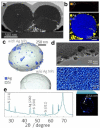Ag-Decorated Si Microspheres Produced by Laser Ablation in Liquid: All-in-One Temperature-Feedback SERS-Based Platform for Nanosensing
- PMID: 36431575
- PMCID: PMC9697265
- DOI: 10.3390/ma15228091
Ag-Decorated Si Microspheres Produced by Laser Ablation in Liquid: All-in-One Temperature-Feedback SERS-Based Platform for Nanosensing
Abstract
Combination of dissimilar materials such as noble metals and common semiconductors within unified nanomaterials holds promise for optoelectronics, catalysis and optical sensing. Meanwhile, difficulty of obtaining such hybrid nanomaterials using common lithography-based techniques stimulates an active search for advanced, inexpensive, and straightforward fabrication methods. Here, we report one-pot one-step synthesis of Ag-decorated Si microspheres via nanosecond laser ablation of monocrystalline silicon in isopropanol containing AgNO3. Laser ablation of bulk silicon creates the suspension of the Si microspheres that host further preferential growth of Ag nanoclusters on their surface upon thermal-induced decomposition of AgNO3 species by subsequently incident laser pulses. The amount of the AgNO3 in the working solution controls the density, morphology, and arrangement of the Ag nanoclusters allowing them to achieve strong and uniform decoration of the Si microsphere surface. Such unique morphology makes Ag-decorated Si microspheres promising for molecular identification based on the surface-enhanced Raman scattering (SERS) effect. In particular, the designed single-particles sensing platform was shown to offer temperature-feedback modality as well as SERS signal enhancement up to 106, allowing reliable detection of the adsorbed molecules and tracing their plasmon-driven catalytic transformations. Considering the ability to control the decoration degree of Si microspheres by Ag nanoclusters via amount of the AgNO3, the developed one-pot easy-to-implement PLAL synthesis holds promise for gram-scale production of high-quality hybrid nanomaterial for various nanophotonics and sensing applications.
Keywords: SERS; hybrid nanomaterials; plasmonics; pulsed laser ablation in liquid; silicon; silver.
Conflict of interest statement
The authors declare no conflict of interest.
Figures




References
-
- Maier S.A. Plasmonics: Fundamentals and Applications. Volume 1. Springer; New York, NY, USA: 2007. p. 245.
-
- Fusco Z., Rahmani M., Tran-Phu T., Ricci C., Kiy A., Kluth P., Della Gaspera E., Motta N., Neshev D., Tricoli A.S.A. Photonic Fractal Metamaterials: A Metal–Semiconductor Platform with Enhanced Volatile-Compound Sensing Performance. Adv. Mater. 2020;32:2002471. doi: 10.1002/adma.202002471. - DOI - PubMed
Grants and funding
LinkOut - more resources
Full Text Sources
Miscellaneous

